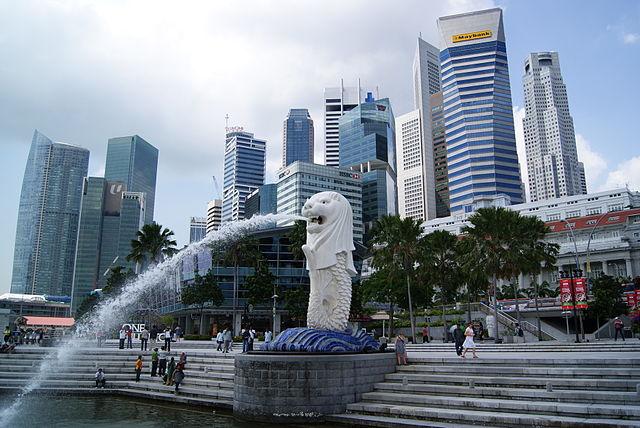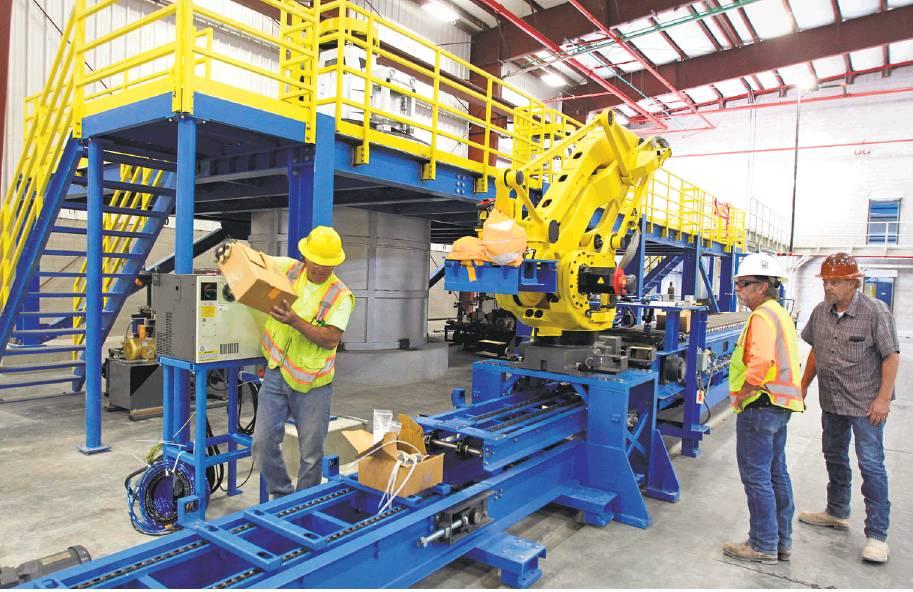Praxis Mutual commits to impact bonds from India, Starbucks, and European Investment Bank


World's Largest Floating Solar Test Bed Comes Online in Singapore


A new floating solar photovoltaic system in Singapore is just one hectare in size and is meant as a prototype. But it could help usher in a new wave of PV placements on water resources globally.
Floating PVs are not new, but they've never been analyzed fully and, thus, only exist on a small scale in a few scattered places. This project aims to understand the true economic and energy impact of such systems, and how they can operate on far larger, and potentially more efficient, scales.
Singapore is an ideal location for this study due to its unique position. It's a developed, small island nation in Southeast Asia with high land costs. These elevated costs make placing large-scale solar plants, such as the massive installation in Morocco or even the large projects in the deserts of the western United States, unfeasible.
This is why the country is making large strides in its own quest for sustainability. Part of that is necessity – they have no fossil fuel energy sources to speak of. But a big part of it is vision, as Singapore aims to be a model for green innovations across Asia and, eventually, the world.
“We have identified floating solar capabilities as a key focus for us," said Goh Chee Kiong, executive director of cleantech and cities, infrastructure, and industrial solutions at the Singapore Economic Development Board, in a press statement. "It’s about grooming our local companies; it’s about attracting international companies to come here to co-innovate with us.”
The project is now testing different models for floating PV to see which are the most efficient and which are scalable. Ideally, the results could be shared and result in new, efficient siting of solar panels across the world. For Singapore, this means potentially siting floating PVs on its reservoirs, which would not only produce clean energy, but may also reduce evaporation and make the reservoirs more water efficient.
“The results of the environmental studies will allow us to make more informed decisions on how some of our reservoirs can support floating solar PV systems in future, after taking into account the economic viability of these systems,” said Tan Nguan Sen, chief sustainability officer for Singapore’s national water agency, in a press statement.
Here in California, where we are dealing with a massive, multi-year drought, the thought of lining our reservoirs -- and perhaps the California Aqueduct -- with floating solar PVs is appealing. Let's hope California's policymakers, and our burgeoning solar sector, are paying attention to the results of this experiment in Singapore.
Image credit: Merlion (Public Domain) via Wikimedia Commons
Polar Vortex 2 Poses Climate Change Risks, Business Opportunities


When discussions of climate change begin, their focus is usually on a warmer planet and the implications such as hotter weather, drought, and other threats ranging from food security to water scarcity. Then citizens living in a cold weather climate suddenly find themselves buried in snow during the middle of winter which, of course, naturally begs the question: Is there really such a thing as climate change or global warming?
Hence some organizations prefer the term “climate volatility,” as many of the risks that society faces involves cases of extreme weather -- as in: the typhoons that wreaked havoc across Southeast Asia or, more recently, Hurricane Matthew’s impact on the Caribbean and the Southeastern U.S. And those events do not necessarily have to occur solely during the warmer months of a calendar year.
In fact, a study published last week in the journal Nature suggests this upcoming winter could have a dramatic impact across the world’s northern regions.
According to the researchers who authored the study, the polar vortex has moved away from North America and closer to Europe and Asia. For decades, those swirling wind patterns remained relatively close to the North Pole, but scientific evidence suggests climate change has disrupted that longstanding trend.
The results could include longer cold spells and a delay in the beginning of spring. The loss of Arctic ice cover is most likely a large contributor to this phenomenon, although the scientists who conducted this study also posit that a surge in snow cover across Europe and Asia is also a factor. The outcome is a weaker polar vortex, which in turn causes Arctic cold to plunge farther south, creating harsher-than-expected winters.
Data accumulated over the past few years suggests that these harsher periods of Arctic chill have become an annual occurrence, but this year’s winter could be more disruptive than the 2013-2014 season. Lost productivity, infrastructure repairs and cancelled flights were amongst the reasons why analysts suggest those several months leading into 2014 cost the U.S. economy a minimum of $5 billion in damages and lost revenues.
Furthermore, an overall warmer climate leads to more evaporation, which in turn sparks an increase in precipitation. Scientific American points to one example a decade ago: Despite the fact that Lake Erie did not freeze over for the first time in recorded history, snowfall in the surrounding region actually increased compared to previous years.
It is important, however, to have some perspective. Despite the drastically cold winters in recent years, the U.S. Department of Energy is one of many organizations that insist temperatures have risen more rapidly than during any other season.
Citizens, therefore, find themselves in the midst of a vicious circle. A difficult winter will lead to an increased demand for natural gas and electricity, resulting in more greenhouse gas emissions. Massive storms can create the double-whammy of economic losses and costly damage to homes, businesses and infrastructure.
This is not to say the future necessarily has to be a dystopian one. Extreme winters actually make the business case for accelerated investment in renewables, as the chaotic 2013-2014 winter and resulting power plant failures gave wind power installations an opportunity to shine. There is also an opening for new and advanced solar technologies that can perform well in such temperatures, such as the Tesla roof tiles that made a splash late last week.
And while the development of clean-energy technologies that still perform well during extreme weather can help the globe meet those pesky COP21 goals, there are plenty of opportunities for entrepreneurs who can help citizens and businesses deal with dramatic winter temperatures now. From better insulation to more resilient building materials to even higher performing greenhouses, improved technologies available today can provide copious business opportunities while providing society the necessary tools to adapt to a climate where constant surprises will be the new normal.
Image credit: Anthony Quintano/Flickr
Chobani Founder Faces Racism, Death Threats For Hiring Immigrants


When Chobani founder Hamdi Ulukaya spoke at the World Economic Forum in Davos, Switzerland, he made both the business and moral case for the private sector to do more to tackle the global refugee crisis. After all, whether they are Syrian or fleeing violence in other countries, refugees often become the hardest-working citizens and strive the most to assimilate into their new home.
NGOs and government agencies only have the capacity to provide the most basic lifesaving and shelter assistance to refugees -- underscoring Ulukaya's reasoning that companies must do more. Creating jobs, insisted the owner of the popular Greek yogurt company, is the best way to cope with the flood of citizens fleeing from Syria, Iraq, Afghanistan, and other countries entrenched in war and sectarian violence.
Ulukaya grew up in what is now largely Kurdish Eastern Turkey and emigrated to the U.S. in 1994. He has long backed up his words with action -- remaining a steadfast and aggressive recruiter of immigrants, including refugees. Chobani often hires resettled refugees and has a reputation for paying a living wage.
In May, Ulukaya signed Warren Buffett’s Giving Pledge, with a commitment to give away most of his wealth to organizations that are helping refugees exiled from their former home countries.
But as the old saying goes, no good deed goes unpunished. Over the past few months, Ulukaya found himself the target of constant trolling on social media. A barrage of rumors and innuendo circulated on websites such as Breitbart. According to the New York Times, he even received death threats.
Never mind the fact that Ulukaya is living the quintessential American dream as a capitalist and employer of at least 2,000 people. After taking a loan from the Small Business Administration in 2005, he purchased a shuttered Kraft Foods plant in upstate New York, a region that long struggled to keep jobs and attract companies. Chobani’s success led Ulukaya to open a second yogurt plant in Twin Falls, Idaho; that 1 million square-foot operation contributes at least $1.3 billion to southern Idaho’s local economy annually.
What is ironic about the invective hurled at Ulukaya is that he is largely going against the grain in the world of business. Chobani already carries a reputation for paying workers a rate far above the minimum wage. And when Ulukaya negotiated a loan with the private equity firm TPG Capital in order to expand Chobani's operations in Idaho, he insisted he be allowed to give all of the company’s employees a stake in the company.
Those options were distributed earlier this spring. They could score newer workers a minimum of $150,000 if Chobani goes public or is sold; the longest tenured employees could become millionaires.
At at time when many American workers feel as if the system is cheating them – leading, some say, to the rise of Bernie Sanders and Donald Trump – Ulukaya rewarded employees for being hard-working and loyal. Instead of moving jobs out of the U.S. or hiring cheap labor, he emerged as one of the most patriotic American business leaders as he is creating economic opportunities.
But Ulukaya included all Americans in this vision, including employees who happen to be Muslim and are from countries such as Syria, Turkey and Afghanistan. Hence we have ongoing protests against a man, and a hero, that are nothing short of a national embarrassment.
Image credit: Chobani
At BSR 2016, Business Leaders Make the Case for Climate Action


The past few weeks will surely prove historic in the fight against climate change.
The Paris climate agreement entered into force at the start of October after gaining buy-in from over 75 countries representing nearly 60 percent of global emissions. Over a dozen additional governments ratified the agreement in the weeks since.
And last week in Kigali, Rwanda, more than 170 countries pledged to cut back their use of hydrofluorocarbon (HFC) refrigerants. This modification to the Montreal Protocol will further reduce greenhouse gas emissions beyond carbon dioxide.
All of this action is intended to limit global temperature rise to 2 degrees Celsius or less. Climate scientists consider this widely-cited figure to be the absolute ceiling if we are to avoid the most severe effects of climate change. And while the ratification of the Paris agreement is encouraging, we already know the government commitments made thus far will not bring us close to the 2-degree target. The latest HFC agreement will limit warming by an estimated half a degree Celsius, but this still leaves a wide gap.
The question of how to complement government commitments and bring the world closer to a 2-degree reality took center stage at the 2016 BSR Conference in New York this week. How can we drive collaboration around climate solutions? How can we bring business to the table? And, most importantly, how can we convince them to take a seat?
According to some business leaders at BSR, a sea change is already underway.
"The business case now is very strong," Peter Harris, director of sustainability for UPS Europe, told TriplePundit in an exclusive interview. "... And it’s not just about corporate philanthropy. This is about actual value to the bottom line."
UPS operates around 100,000 vehicles and clocks over 3 billion miles a year. So, the multinational logistics company is in a position to make a significant impact on global greenhouse gas emissions. Through increased fleet efficiency and the deployment of alternative vehicles, UPS managed to exceed a 10 percent reduction in carbon intensity three years ahead of its 2016 goal. The company since upped the ante and now plans to cut carbon intensity by 20 percent by 2020, using a 2007 baseline.
Such momentum, Harris insisted, enabled the company to transform what were once the business risks associated with climate change into new chances to improve its reputation and reap returns.
"The great thing about innovating in relation to [climate risks] is that you find yourself in a position where the risks turn into opportunities," he told 3p. "So, for example, what could be a brand risk can be a brand opportunity by innovating and being seen as a leader. What could be a risk of disengaging employees becomes an opportunity to engage those employees"... What could be a regulatory risk turns into an opportunity to shape the debate. And what could be a revenue risk from disenfranchising customers turns into an opportunity to engage with customers who want the same solutions to the problems that we do."
These efforts to tackle climate change dovetail with other 21st-century realities, from urbanization and automation to an increased strain on natural resources. With such a complex and uncertain future before us, it makes sense for companies to begin with an undertaking that's close to home. For UPS, it is driving efficiency and adopting alternative transport solutions to meet the demand for global trade without increased emissions.
For aerospace and defense firm Lockheed Martin, it is adopting more renewable energy. In February, the New York-based company inked an agreement with Duke Energy Renewables to produce 30 megawatts of solar energy for the national grid. The company, whose largest client is the federal government, now meets 16 percent of its power needs through renewables and renewable energy credits. With the U.S. Energy Department targeting 30 percent renewable energy use by 2025, it makes sense for Lockheed Martin to align its own practices with that of its largest customer, Scott Stallard, the company's senior manager for environmental stewardship, said on Wednesday.
"It just makes good, sound financial sense to diversify [our energy portfolio]," Stallard said. "Of course that argument only goes so far -- you’re not going to get to 100 percent renewable energy. I would love to get there someday as an environmentalist, but right now I’m happy to get a chunk of our buy. We’re really mitigating risks."
Some firms are further along the journey than others. But as business leaders continue to innovate and conference centers continue to fill with people hungry for discussion, there's a lot to feel good about.
"It’s exciting to see so many companies reinvent themselves and reinvent themselves with new business models," added Susan Hauser, vice president of business and corporate responsibility for Microsoft. She used a kooky example -- the story of Japanese electronics maker Fujitsu which, with Microsoft's help, transformed an unprofitable semiconductor factory into an indoor lettuce farm -- to prove sustainable growth comes in all shapes and sizes.
"It isn’t going to happen by just us saying it’s going to happen," she continued. "We will have to make changes; we will have to come together. But if we do, there’s so much opportunity."
TriplePundit will be at BSR 2016 today and at the Net Impact conference this weekend. Check back to the homepage for updates. And if you're headed to Philly for Net Impact, come grab a drink with us at the Field House on Friday night.
Image credit: Pixabay
Next-Gen Lead Battery Recycling Plant Opens in Nevada


The vast majority of the world’s large batteries are still comprised of lead. And despite their toxicity and cumbersome weight, lead-acid batteries are still the preferred technology to provide electrical current for automobiles. According to one NGO, used lead battery recycling is the world’s most polluting industry, based on its threat to human health in much of the developing world.
In countries like the U.S., the recycling of lead-acid batteries, while an imperfect technology, is relatively benign; and in fairness to the automotive industry, approximately 98 percent of these batteries end up recycled in the states. But as Damian Carrington profiled last week in the Guardian, old lead batteries are in demand throughout emerging economies, such as China, as more people are able to afford cars. And many citizens are at risk as these batteries are often disassembled with pickaxes and hammers.
The results include the increased contamination of soil and water as much of this recycling work is done in people’s homes and yards. Considering how poisonous lead is, one unwanted car battery left in a dumpster is one battery too many.
One startup, Aqua Metals, claims it has developed a lead-acid battery recycling process that could be a game changer and reduce this industry’s environmental impact -- if it can scale.
Aqua Metals opened a new lead recycling plant in McCarran, Nevada, a 15-minute drive east of Reno and just a few miles away from Tesla’s battery “gigafactory.” The procedure, which the company calls “AquaRefining,” relies on a reusable water-based technology. An electromagnetic process extracts the lead from other battery materials, resulting in a recycled product that is 99.99 percent pure lead, Aqua Metals says.
According to the company, this is a much more energy-efficient process compared to the traditional lead smelting technologies that were long used to salvage lead from batteries. In addition, Aqua Metals says very little sulfur dioxide is emitted at its new plant; it also sends no lead slag to landfills and cuts greenhouse gas emissions by 80 percent compared to a conventional lead smelter.
Most press reports indicate the cost of Aqua Metals’ recycling plant was around $30 million. In May, the automobile manufacturer Interstate Batteries invested $10 million in the recycling startup, and also gave Aqua Metals at least 1 million used batteries for recycling at the Nevada facility.
Whether this is a technology that can transform the lead-acid battery industry remains to be seen. Since the company’s $36 million initial public offering last year, its stock remained relatively flat. After hovering around $5 a share for most of 2015, its share price reached over $12 this summer. At press time, the stock was valued at $8.40; despite the splash made over the company’s recycling plant opening, investors so far appear nonplussed.
The challenge for Aqua Metals is for its recycling plant to keep up with demand and prove to be a viable long-term solution for an almost 160-year-old technology the United Nations says poses huge risks to human health and the environment. If the company can eventually expand or even license this technology, it could help clean up an industry which, despite new innovations in battery technology, in reality is not going away at any point soon.
Image credit: Aqua Metals
The Lifecycle Impact of Electric Vehicles


By Holly Whitman
Many consumers, manufacturers and government officials view electric cars as the answer – or at least a big part of the answer – to the disastrous effect our personal transportation has on our environment.
Electric vehicles have yet to become commonplace, but their popularity is on the rise. In fact, in the first three quarters of 2016, electric vehicle sales were 33 percent higher than they were in the first three quarters of 2015.
Some, however, question whether or not electric vehicles are really all that green. How could that be? Eliminating the need for gasoline gets rid of all those nasty emissions coming out of your tailpipe, so it must be environmentally friendly. It turns out it’s not quite that simple.
Concerns about electric vehicles
An electric car doesn’t create emissions as you drive. But there are emissions associated with these vehicles; they're just further removed from the consumer. These issues exist in two main categories:
- The manufacturing process
Critics point out the energy-intensive production process needed to manufacture electric vehicles, which they say negates their cleaner operation. The production of electric vehicles creates more emissions than the production of gas-powered vehicles, largely because of the lithium-ion batteries in electric cars.
Much of this impact comes from the mining of metals used in the production of these vehicles and batteries. Exactly how much of an impact this has is difficult to measure. Gas-powered vehicles require many of these same metals, giving neither the advantage in this area outside of the battery.
Improving the batteries used in electric vehicles will lessen the impact of their manufacturing process, making the cars greener over their lifetime. These improvements will likely come as the technology progresses and electric cars become more popular.
- Energy production
The other big factor in the greenness of an electric vehicle varies by location and even what time of day the vehicle charges. These factors influence how the electricity that runs the vehicle is produced, which can really make or break an electric vehicle as far as environmental friendliness goes.
If the electricity comes exclusively from coal, the impact would be about the same as a traditional vehicle. With natural gas, the car would perform about as well as an efficient hybrid. However, if the electricity comes from renewable sources like hydro or solar, electric vehicles are much better for the environment.
Here are some examples of how electric vehicles perform in different countries over their entire lifetime based on how those countries on average produce their electricity. In the U.S., an electric car performs just slightly worse than the average hybrid vehicle. In India, which uses coal heavily to produce electricity, the impact of an electric and gasoline vehicle are the same. In Brazil, however, electric vehicles perform better than any other type of vehicle.
Impact post-use
Much of the talk about vehicles’ environmental impact centers on the period when they’re in use. As mentioned earlier, the manufacturing process also creates significant emissions. Another little-mentioned factor is what happens when the car has reached the end of its useful life. How can it be disposed of; is it reused or recycled?
Electric vehicles are so new that this period has not really been explored yet. Few companies now have the technology to recycle the lithium-ion batteries used in electric cars, especially not in an economical way. That will likely change, however, as electric cars gain in popularity and the demand for these recycling services increases.
Shades of green
So, how green are electric vehicles really? Well, it depends. How the electricity that runs the car is produced plays a big role. Currently, the manufacturing process is not especially environmentally friendly, and the recycling process still needs to be explored.
However, electric cars at their worst have the same environmental impact as a gas-powered vehicle. Usually, though, they are better for the environment. In fact, the Union of Concerned Scientists found that on average an electric vehicle creates half the emissions of a regular car over its lifetime, even when including the manufacturing process.
This is a significant improvement when comparing more modern vehicles to those of the 1960s and '70s, or even those of the early 2000s. Plus, as the technology improves, electric cars will likely become even greener.
Electric cars aren’t perfect. They still produce some pollution, and exactly how green they are varies by location. However, they’re usually still greener than a conventional vehicle and remain a promising new technology.
Image credit: Pixabay
Holly Whitman is a writer and journalist tackling global issues from environmental problems to human rights. You can find her on Twitter at @hollykwhitman or her blog, Only Slightly Biased.
Families Rise Out of Poverty With Financial Health Metrics


By Toni Johnson
As the Heron Foundation pursues its mission to help people and communities lift themselves out of poverty, it held a retreat this summer so 13 of its grantees could come together and share their progress.
I sat down with representatives of each to delve into their stories, learning more about how they are using the philanthropic equity provided by Heron to grow their enterprises and ultimately make a greater impact on building a more inclusive and prosperous economy. This is the first of a series of transcripts of those conversations.
Jennifer Tescher is president and CEO of the Center for Financial Services Innovation (CFSI). We discussed how the financial industry is learning to evaluate its own success by measuring its impacts on consumers' financial health. (The full audio interview is also available for free on iTunes.)
Toni Johnson: Give us a sense of what is CFSI. Why is it important? What work do you do?
Jennifer Tescher: We are the leading experts on consumer financial health, and we lead a network of financial services and technology companies that are committed to building the kinds of high-quality products and practices that will help their customers ultimately achieve financial well-being.
Johnson: CFSI received an Enterprise Capital Grant from Heron, as part of its overall capital raise. What's the money for, and how's it working with the organization?
Tescher: We were so grateful to receive this investment from Heron because we had spent about 10 years building a market in a field that hadn't existed before. And we felt like we were poised to really grow our impact, to scale it. But to do that we needed to reorganize and repackage both the value we were providing into the market and the way we were organized internally to deliver it.
So, we were reorganizing ourselves into a membership network and needed to build the kind of sales and relationship management staff, the kind of technology and CRM infrastructure that was needed to do that. And, simultaneously, we also wanted to start growing and scaling an existing consulting businesses that we expected would grow, in part, as our network grew. We needed to hire more consultants; we needed to template-ize and product-ize some of our offerings. So, the investment from Heron and others has been really critical, and we're really excited because we're starting to see some success.
Johnson: From our point of view, financial services is still a critical piece to helping people and communities lift themselves out of poverty. Can you talk a little bit about the impact that CFSI is having, particularly on low-income people and communities?
Tescher: We're really trying to communicate a pretty big idea to the financial services industry: that they should be building businesses that make money because and when their customers succeed. Not in spite of their customers -- which is what we saw, frankly, in the build-up to the financial crisis.
We are trying to make the case that they should see themselves as being in the financial health business. And that they should be making sure that the products and services they offer and the policies and practices behind them are actually moving the needle, that they are being helpful or, at the worst case, neutral. But in order to do that, we've got to start measuring because you tend to manage what you measure.
Our theory is that by growing our network, that enables us to reach ultimately more Americans and more low and moderate income families. The more we reach into those markets and we engage with them more deeply, the more new products and strategies are built and delivered. And ultimately, the more we get our network to drink the Kool-Aid, the more likely they are to start actually measuring their own success in impacting their customers' financial health.
Our network, as an example, has just in the last 18 months doubled in size. We now have about 110 companies and organizations. Just to put that into perspective: They touch, we estimate, 174 million consumers, 43 million of whom are low and moderate income. So, if we grew our network not another iota, we are already working with firms that are reaching a massive number of the people that we care about. Just in the last year and a half as an example, we have seen and worked with companies to create at least a dozen new products or strategies or changes to practice that are high quality and that we think are going to move the needle.
And most excitingly, just earlier this year we launched a set of financial health indicators. How do I know if someone is financially healthy? And we just announced a beta test with a group of about 8 providers of varying sizes and types, who over the next six months are going to be analyzing their own customer data and some cases gathering some survey data, so that they for the first time can actually measure the financial health of their customers and then reflect on their products and services and what they might need to change in order to help their customers improve. So we're really excited that were on the way to our 2018 goal of having at least 25 percent of our network investing in and measuring the financial health of their customers.
Johnson: So you said network. Can you just give our listeners a sense of what these companies look like? Can you just name a few and what do they do?
Tescher: It's a very broad array, so we have some of the biggest banks in America such as Bank of America, Chase, Wells, Citi and others, regional and super regional banks. We have a number of credit unions; we have technology companies that are vendors to providers. So we have Visa and MasterCard; we have American Express; we have the big credit bureaus; we have the big technology vendors that service these companies.
Then we have an array of earlier-stage, technology-driven companies that are trying to enter this market. We have retailers who see themselves as delivering financial products and services; we have some nonprofits who see themselves as being in the business of delivering. It is an incredibly broad array of providers who feel committed to this bigger idea, [and] that frankly is bigger than any one of those companies.
Johnson: Is there a story that can sort of anchor what this looks like for a person or community on the ground?
Tescher: About a year ago, we met and recruited a new company to our network, Wright-Patt Credit Union. They are the largest credit union in the state of Ohio. They have 300,000 members and about $3.3 billion in assets -- not the largest company we work with, but absolutely not the smallest. And they came to us and got excited about our network because this concept of financial health really resonated with them and it was similar to something they were trying to pursue but hadn't been able to put their fingers on it yet.
As they got to know us and understand more about our thinking and our framework, they hired us through our consulting practice to come and survey their customers using our financial health survey instrument, to really do a financial health checkup and to really understand how their customers are faring and to segment them. They also hired us to review almost every product in their suite, whether it's checking accounts or loans or savings products, to assess how well they are designed and offered, from the perspective of what the needs of their customers are. And really even more revolutionary, they've then asked us to do the same survey for their 700 employees because they understood that you have to put your own oxygen mask on first.
If we want employees of financial institutions to be successful in working with customers, especially those who are struggling, it's kind of hard to do that if you're struggling in the same way and don't have the resources -- whether those are tools or products or advice -- to be able to make their own improvements. And so we are incredibly excited that our network members aren't just buying into this thinking; they are helping us actually advance the practice. And now, a bunch of other credit unions that they are in a relationship with are asking us to do the same thing, and we're now starting to talk to employers outside of financial services about the financial health of their employees.
And so, what's so powerful -- as we think about this network -- is really the network effect. It's not just the one-to-one interactions that we have with any given company, but it's the interactions that those companies have amongst themselves in building a movement, building best practice, and ultimately demonstrating that financial services can really be a force for good in people's lives, especially for those who are struggling.
Image credit: Pixabay
Toni Johnson is vice president of knowledge and influence for the Heron Foundation whose mission is to help people and communities help themselves out of poverty.
Rethink the Runway: Mainstreaming Sustainable Fashion


By Ken Alterman, CEO of Savers
It is becoming increasingly clear that the public wants to make greener fashion choices. As more people learn about the impact of their clothing, they want to be empowered to make more informed shopping decisions. According to the Savers State of Reuse Report, more than half of North Americans report they are more likely to practice reuse after learning about the clothing industry’s environmental footprint.
But there’s a problem: People can’t choose sustainably-sourced clothing if it’s not available on the shelves.
The clothing industry has quietly become one of the biggest polluters in the world. The public is only now starting to hear about it through the recent wave of events, films, dialogues and research studies. With the production of a single cotton T-shirt requiring over 700 gallons of water, the fashion industry is now being confronted with the strain it puts on our planet’s finite resources.
Eileen Fisher is one industry leader to publicly acknowledge the devastating environmental impact of the fashion industry, and has unwaveringly pledged to change. Eileen Fisher’s Vision 2020 initiative is guiding her business toward 100 percent sustainable practices while still creating high-quality, timeless and fashionable garments.
Although it may not be apparent that Fisher is blazing a trail when you walk into the nearest mall or department store, she is one of many designers and organizations that remained committed to eco-friendly and sustainable fashion for years.
Take Eco Fashion Week, a nonprofit organization that is dedicated to discovering solutions and innovations to help advance the fashion industry in a sustainable and responsible direction. Founder and President Myriam Laroche uses her deep understanding of retail buying to empower designers, retailers and stylists to embrace sustainable fashion.
And after 10 successful years in Vancouver, Canada, Eco Fashion Week brought the world’s largest sustainable fashion show to Seattle this year to further its mission – highlighting fashion rooted in zero-waste production, eco-friendly textile treatment and development, and the environmentally conscious disposal of unwanted clothing. Two days of runway shows celebrated unique collections fashioned from sustainable materials as well as reclaimed materials.
These efforts are pushing the fashion industry in the right direction, but there is still more work to be done. With high price tags and limited selection, sustainable fashion can seem unattainable to the average person. To truly move the needle and minimize our clothing footprint, sustainable fashion must become mainstream.
From how cotton is grown, fabrics are dyed and garments are manufactured, to how owners care for these items and whether unwanted garments are repurposed or recycled to ensure a second life, sustainably-sourced fashion begins long before a garment is placed on a shelf. And it ends far after a person no longer wears it. Both shoppers and retailers must acknowledge that the real cost of clothing is more than what’s printed on the price tag.
Committing to the affordability, availability and increased visibility of sustainable garments is only part of the solution. As Runway Reimagined at Eco Fashion Week demonstrated, it’s also important for designers, artists and manufacturers to consider what happens to their discarded garments. When over 95 percent of textile and clothing waste sent to landfills is recoverable through recycling or reuse, it’s a huge loss to simply toss these goods away. Runway Reimagined challenged designers and stylists to use unsold secondhand clothing and textiles to create new looks, because the most sustainable fashion is fashion that already exists.
From the production of a garment to its disposal, we must continue to seek out innovative solutions. Given that over 80 billion new pieces of clothing will be purchased this year alone – 400 percent more than we consumed 20 years ago – Savers feels this is an important challenge. Now more than ever, we have an opportunity to create a sustainable fashion future, one that fosters sustainable production and distribution while also addressing waste as a part of the fashion industry. How our industry chooses to respond to these challenges is up to us.
Image credit: Flickr/Matt Dunham
Ken Alterman is the President and CEO of Savers.
7 Global Food Conglomerates Partner on Water Stewardship Commitments


Last week, seven global food and beverage companies made commitments to work with thousands of farmers in their global supply chains to reduce water use and pollution impacts.
The firms in question are Diageo, General Mills, Hain Celestial, Hormel Foods, Kellogg, PepsiCo and WhiteWave Foods, and they are participating in the AgWater Challenge: a collaborative initiative organized by Ceres and the World Wildlife Fund (WWF).
The companies submitted detailed sustainable sourcing and water stewardship plans. A progress report on their commitments will be published in a year.
Such a collaboration is vital because a third of the world’s food is grown in areas of high water stress or competition. Agriculture also consumes a massive amount of water and is a leading cause of global water pollution. The food sector uses 70 percent of global freshwater supplies, mainly to grow crops.
“Without an adequate supply of water, food companies have no business,” Eliza Roberts, manager of the Water Program at Ceres, told TriplePundit. Three factors are “depleting freshwater resources around the world,” she told us: climate change, population growth and water pollution. “Global food companies are already facing materials risks, including disruption of operation, higher operating costs, and constraints to growth.”
Every business needs water to operate. However, consumers generally don’t realize just how much water is needed to produce the food they eat. “When consumers think about the role of water in business, they think about the water that a company uses within its own four walls or as a direct ingredient in a beverage,” Roberts pointed out. “But the reality is that the bulk of water in the food sector is used to grow the food that we eat.”
The AgWater Challenge includes five categories: setting time-bound goal for completing a water risk assessment across the companies' supply chains; setting sustainable sourcing goals; setting time-bound goals to reduce the water impacts of key crops; support farmers to steward water resources; and collaboration at the watershed level to protect resources in high-risk areas. All companies committed to completing a water risk assessment by 2017.
Three of the seven companies -- Diageo, General Mills and Kellogg -- were recognized as AgWater Stewards for their actions across all five categories. These three firms already have water stewardship commitments on the books. Diageo defines its approach to water stewardship through the Diageo Water Blueprint. It is based on four core areas: raw materials sourcing, operations, the communities where it operates, and local and global advocacy for best practices in water stewardship. Diago also committed to establish partnerships with farmers to develop sustainable agricultural supplies of six raw materials by 2020. By the same year, the company will ensure sustainable water stewardship on 100 percent of owned agricultural land.
General Mills committed to champion the development of water stewardship plans by 2025 for the most material and at-risk watersheds in its global value chain. The global food company committed to sustainably source its top 10 ingredients (palm oil, fiber packaging, wheat, oats, sugar beets, vanilla, cocoa, dairy, corn and sugarcane) by 2020.
Kellogg Co. committed to responsibly source by 2020 its global 10 priority ingredients by measuring continuously improvement for row crops through metrics focused on several factors, including water and fertilizer use. It also committed to support 17,000 agricultural suppliers, millers and farmers in 22 countries to optimize water use and improve watershed quality.
New commitments by the other four companies include:
- The Hain Celestial Group will complete a water risk assessment across its entire supply chain by the end of 2017. The company will use this assessment to implement a watershed-by-watershed strategy to reduce water use and pollution risks linked to agricultural production.
- Hormel Foods will develop a sustainable agriculture policy over the next three months, requiring all direct suppliers, contract animal and feed grain farmers to meet best environmental practices for reducing water pollution risks.
- PepsiCo plans to improve the water-use efficiency of its direct agricultural supply chain (citrus, corn, oats and potatoes) by 15 percent in high water risk sourcing areas.
- WhiteWave Foods will develop a time-bound roadmap for agricultural water stewardship by 2018. The roadmap will address the watershed challenges of dairy, soy, almond and produce in areas of greatest water risk, including California.
Image credit: Flickr/USFWS Mountain Prairie